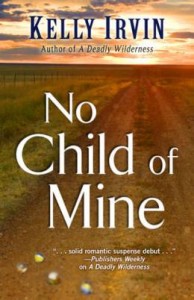It’s my pleasure to welcome Kelly Irvin to my blog today. By reading her website bio, I discovered that Kelly worked as a journalist for many years, “six years in the border towns of Laredo and El Paso, where she was exposed to culture and language that serves as fodder for her fiction writing. She has written hard news, features, entertainment pieces, restaurant critiques, editorials, and weekly columns.”
Her latest novel, No Child of Mine, is scheduled for release on October 12. It sounds like a good one:
It “begins the day Daniel Martinez’s foster son Benny Garza is kidnapped at Homicide Detective Ray Johnson’s wedding reception in Helotes, Texas. In their search for Benny, Detectives Deborah Smith and Alex Luna find the bones of a little girl not far from the abduction site.
Determined to save Benny and solve a five-year-old murder, the team of investigators travel from the seamy underside of San Antonio’s drug dealing gang territory to the back roads of rural America where secrets fester in simple country homes.”
————————-
Writing Tasty Scenes by Kelly Irvin, Guest Blogger
 When it comes to using my five senses to make scenes three dimensional on a flat piece of paper (or a computer screen) I have no problems with seeing, hearing, or even smelling. Where I find myself struggling is with the other two: taste and touch. Quite often, unless it’s a restaurant scene or a love scene—and no, we’re not going there—writers in general seem to have difficulty with taste and touch. We use the same bitter bile in the throat thing over and over again. Tree bark is rough under our heroine’s fingers as she hides from the villain.
When it comes to using my five senses to make scenes three dimensional on a flat piece of paper (or a computer screen) I have no problems with seeing, hearing, or even smelling. Where I find myself struggling is with the other two: taste and touch. Quite often, unless it’s a restaurant scene or a love scene—and no, we’re not going there—writers in general seem to have difficulty with taste and touch. We use the same bitter bile in the throat thing over and over again. Tree bark is rough under our heroine’s fingers as she hides from the villain.
What smells, tastes, and touches can you imagine that will thrust readers into the scene, making it vivid for them, and at the same time, propelling the story forward? That’s truly the hard part. Not throwing in random stuff with no meaning. These sensory details must tell us something about the characters, help us understand them, and move the story forward.
No problem. Right?
Smells are a fairly easy way of planting your reader in a scene. But we often resort to the cliché even here—the smell of newly cut grass, freshly brewed coffee—when there are so many from which we can choose. In my new release, No Child of Mine, the book opens in the point-of-view of a seven-year-old boy who is abducted in the first scene. Smells heighten Benny’s fear as he’s snatched by a man who slaps his huge, sweaty hand over Benny’s mouth and nose. Benny smells the man’s sweat. Then he’s thrown into a car trunk and the assailant bends over him, his breath on Benny’s face. It’s so bad it gags the child. After the trunk closes, he’s left in the dark where he can smell oil and gas. The smells keep the reader right there with a terrified little boy.
 So what about taste? It’s tougher. Benny’s eating a fajita taco as he trots along the road to his foster dad’s car. For a malnourished kid who’s gone hungry on more than one occasion it tastes good and represents a sense of security that will be destroyed only a few minutes later.
So what about taste? It’s tougher. Benny’s eating a fajita taco as he trots along the road to his foster dad’s car. For a malnourished kid who’s gone hungry on more than one occasion it tastes good and represents a sense of security that will be destroyed only a few minutes later.
Recently I challenged myself to use all five senses in the opening scene of a new piece. As always seeing and hearing were not a problem. My heroine is at the library reading to a group of children when a vet, who lost a leg in Afghanistan, tumbles down the stairs. In my new manuscript, we see the kids gathered around, raptly listening to the story. We hear the tale told by the heroine. We smell what the heroine describes as her favorite perfume, eau de books. We hear the thump, thump on the stairs when the vet falls. So far so good.
I longed to take care of taste by having my hero, the vet, bit his tongue in the fall and taste salty blood. Which would connect nicely back to horrific memories of battles, won and lost, where the blood of his buddies was shed. Problem? The scene is written in my heroine’s POV. No cheating allowed. At the moment, I’m still struggling with taste in this particular scene.
Touch. My heroine stoops to help the hero pick up books from the floor. Her hand brushes his and touches rough, ropy scars from burns he suffered in the war. Scars that represent much deeper unseen wounds. She draws back. He assumes she’s repulsed. She’s not. So begins the tension between them, marking the start of a complicated relationship. This first encounter sets the stage for the development of both characters.
Using all the senses makes for a richer, more vivid experience for readers. Being able to connect them to the story serves to heighten the drama. It’s a tall order, but writers like that. We live for tall tales and tall orders. So breathe deep, keep your eyes and ears open and don’t forget to taste every word.
If you have any ideas for using taste in my scene, please let me know!
————————-
Thanks so much for being my guest today, Kelly.
For more information about Kelly and her books, visit her website and look for her on Facebook.






I did enjoy this timely hint of use of all senses and will try to keep it in mind especially in my current effort to do a ghost tale, Runaway Pumpkin based on something I saw Thursday.
Poetry is a great example. Such a challenge. Reading it and writing it can help us sharpen our wordsmithing.
Great examples! Thanks for reminding me to check those scenes for the 5 senses.
PamT
Hi, Kelly and Pat,
Good writing is all about sense imagery. I agree with you. When I taught creative writing courses, I always started with poetry because writing poems is about appealing to the senses. Kelly, best of luck with your new novel which sounds like a terrific books!
Jacqueline Seewald
THE TRUTH SLEUTH
When I first started blogging, Pat, your reviews impressed me. They still do. This is another in a long list of great ones!
And thanks for stopping by a few days ago to comment on my ghost writing post. I’m making progress, inch by inch. I appreciate your encouraging words!
Ann Best, Author of In the Mirror, A Memoir of Shattered Secrets
Excellent ideas. I definitely think there would be some dust in the air at this little library. I love being totally immersed in the fictional world of the characters. The senses help with that and don’t have to slow the story down if done right. Thanks for the input!
Excellent reminders to all. Heroine might bite the inside of her lip and experience that coppery taste of her own blood. Fear and alarm have tastes to me and my stomach plummets when adult or child falls or is in danger. All five senses, plus that premonition thing (a sixth) need to be remembered to change readers from spectators to participants.
This is something I need to concentrate on when I write. I’m terrible about it when I don’t.
I’d say that the air she inhales tastes like dust when she gasps at the guy’s fall…
🙂
This comment has been removed by the author.
We just had this discussion about engaging the five senses in a NCW morning meeting. I enjoy being absorbed with all of my senses in what I read.
Maybe one of the kids digs a piece of old breakfast out of their teeth and re-investigates the flavor…and texture…feeling with the mouth, not with the hands.
Margot, I try to be a spare writer but find the five senses creeping into more and more of my tight descriptions. I guess that’s a good thing.
That’s a good idea, Jan. Another thing is to taste something in the air — we say that about wood smoke, for instance.
Alex, having a deficiency in one of the senses would definitely handicap a writer. My hard-of-hearing husband would no doubt forget to describe the high-pitched whine of the refrigerator if he tried to write something.
Taste is a challenge although I struggle more with smell. I don’t have a great sense of smell so I often forget it. Touch is a little easier though.
I have a note above my desk reminding me to include the senses. But I still need to remember to look at the note! It is such a great tool if only we would develop it.
Now, sense of taste for your protagonist in that scene…could you have her bite her tongue when she startles after hearing the vet fall? I like the idea of that metallic taste happening concurrently with her first notion of this person in her life.
Pat – Thanks for hosting Kelly.
Kelly – Thanks for taking us through the way you used the five senses to draw the reader into your story. When you break it down like that, it seems like such an easy thing to do (although of course, it’s not). And the result adds so much to the story. Thanks for this. And I wish you much success with No Child of Mine.